#agrigento
Explore tagged Tumblr posts
Text
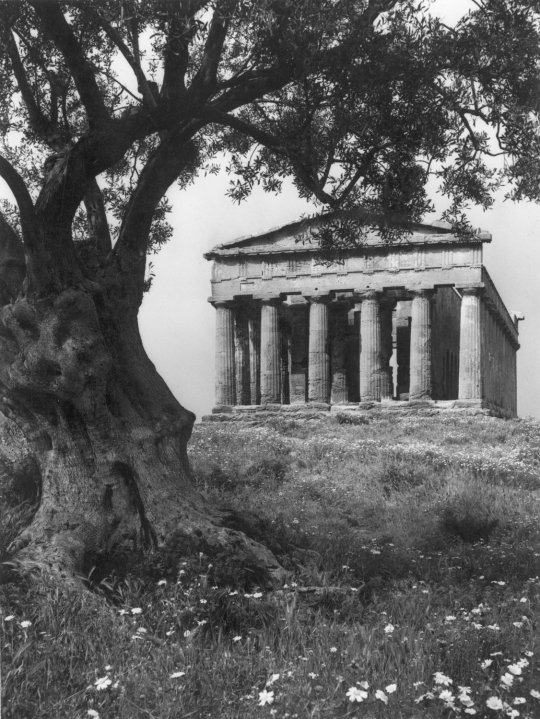
'Tempio della Concordia,' 1955,
Valley of the Temples, Agrigento, Sicily, Italy,
Photo by Konrad Helbig
#art#history#design#style#sculpture#antiquity#architecture#temple#vintage photography#sicily#italy#konrad helbig#concordia#agrigento#akragas
1K notes
·
View notes
Text
📍Temple of Juno,Agrigento,Italy 🇮🇹
The temple of Juno in the Valley of the Temples, also known as Temple D, was built on the highest part of the ancient Greek city of Akragas (today’s Agrigento) around the mid-5th century BC.
It was dedicated to the Greek goddess Hera (Juno), protector of fertility and procreation; in fact the main ceremonies that took place inside were marriage unions.
The Temple is in Doric style and has a colonnaded perimeter (peripter), with six columns on the short sides (hexastyle) and 13 on the long sides. During the Carthaginian siege of Akragas in 406 BC, the structure was subjected to a fire, traces of which are still evident along the walls of the cell (naos).
It was then restored in Roman times.
@antiqua_archeologia
#travel #travelingare #dronephotography #architecture #ancient #italy #agrigento #akragas #sicily #valledeitempli #dorictemple #ancientgreek #archeology #archeologia
#lifestyle#myuploads#aesthetic#travel#travelingare#photography#architecture#drone photography#sicily#italy#agrigento#akragas#ancient greek#archeology
53 notes
·
View notes
Text

View of part of the ruins of the Temple of Juno Lacinia in Agrigento
by Louis-François Cassas
#louis françois cassas#art#ruins#architecture#landscape#temple#temples#temple of juno lacinia#agrigento#sicily#mediterranean#magna graecia#europe#european#classical antiquity#ancient greek#ancient greece
88 notes
·
View notes
Text

Temple of Concordia, one of best preserved Ancient Greek temples in the world.
Agrigento, Italy
#agrigento#italy#italia#ancient greece#ancient greek#ancient ruins#ruins#temple#greek temple#valley of the temples#photography#original photography#travel#photographers on tumblr#lensblr#architecture#historical architecture#ancient architecture#wanderingjana#sicily#sicilia
116 notes
·
View notes
Text

P-39 13x21cm 2024 michael pontieri
56 notes
·
View notes
Text


agrigento/sicily series 182
© 2022 Yiannis Krikis
#agrigento#lensblr#lensculture#fine art photography#photographers on tumblr#urban#music#people#black and white#italy#sicily
22 notes
·
View notes
Photo

Gela
Gela (Greek: Ghéla), in southern Sicily, was a Greek colony founded c. 689 BCE and it remained an important cultural centre throughout antiquity. Prospering on trade and expanding its territory, the city-state founded Agrigento. In the 5th century BCE the tyrant Gelon reigned with success but the end of that century brought attacks and destruction by Carthage. The city revived thanks to the Corinthian general Timoleon but was destroyed in 282 BCE by Phintias, ironically the tyrant of Agrigento.
Foundation
Gela is located on a long and low hill running parallel to the Mediterranean sea on the southern coast of Sicily. The first settlements in the area date back to the copper age (2800-2170 BCE) with the town of Gela being founded c. 689 BCE by Greek colonists from Rhodes and Crete, amongst whom were Antifemo of Rhodes and Entimo of Crete. The town was initially called Lindioi and then changed to Gela shortly afterwards after the nearby river.
The foundation of Gela was one of the most daring enterprises of Greek colonization in Sicily because it took possession of the island's southern coast, dangerous for the presence of the important indigenous Sicanian and Siculis centres. When the Rhodium-Cretans landed they reduced the local people to the servile state (except perhaps the women they took as wives in the first two generations), occupied the plains and the surrounding hills, and merged the indigenous culture with their own.
Continue reading...
33 notes
·
View notes
Text

A Statue of Atlas Emerges From the Ruins of Sicily’s Ancient Temple of Zeus
In the fifth century B.C.E., 38 looming sculptures of the Titan stood guard at the structure.
After 20 years of restorations, a 26-foot-tall statue of Atlas is once again standing guard at the ancient Temple of Zeus in the city of Agrigento (once called Akragas) in Sicily.
The statue, created in the fifth century B.C.E., was one of roughly 38 similar Atlas monuments built into the temple. They stood in a line between columns with their arms raised, appearing to hold the holy structure upright.
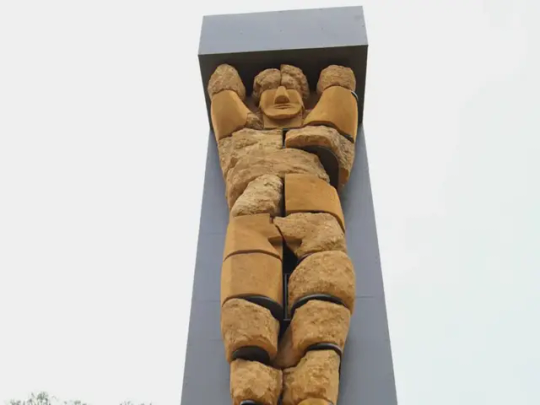
In Greek mythology, Atlas was a Titan who rebelled in a war against Zeus. As punishment, he was forced to hold up the sky on his shoulders. Unlike the mythological Atlas, however, the stone likenesses were unable to hold up Zeus’ temple forever. Ultimately, earthquakes and other events caused the structure to crumble.
For many years, pieces of the statues were scattered around the site amongst other ancient ruins. In 1812, Charles Robert Cockerell, a prominent British architect, first identified one of the Titan’s giant sandstone heads during a visit to Agrigento. A century later, in 1920, archaeologist Pirro Marconi became the first person to attempt to reconstruct one of the Atlases, which is now housed in the Archaeological Museum of Agrigento.
The seeds of the current project began in 2004, when the Valley of the Temples park conducted a sweeping research campaign at the site. Experts cataloged 90 fragments from at least eight Atlas statues.
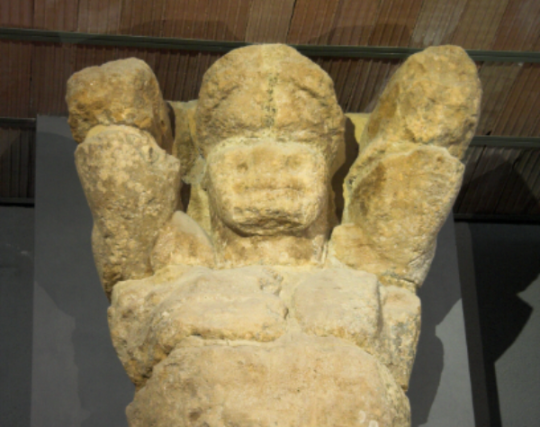
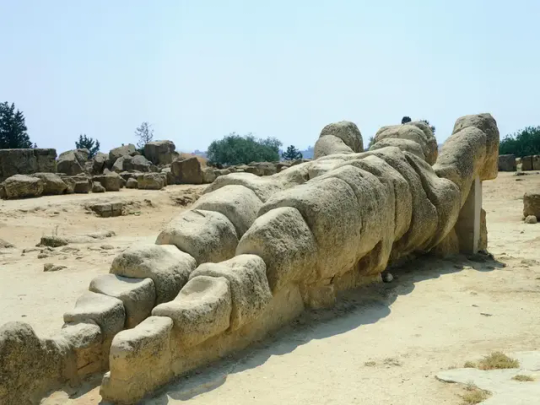

“The idea was to reposition one of these Atlases in front of the temple so that it may serve as a guardian of the structure dedicated to the father of the gods,” Roberto Sciarratta, the director of the Valley of the Temples park, tells the Guardian’s Lorenzo Tondo.
But rebuilding Atlas in a standing position was particularly challenging, as researchers couldn’t simply stack the pieces of the statue on top of one another. Instead, they attached the fragments to metal shelves, which are supported by a larger metal structure.
The restoration has faced scrutiny ever since officials first announced it several years ago.
“No archaeologist would endorse the use of ancient sculpture, no matter how fragmentary, to create a modern sculpture, even if the purpose is to highlight the site’s antiquity,” C. Brian Rose, an archaeologist at the University of Pennsylvania, told the New York Times’ Franz Lidz in 2020.
But officials like Renato Schifani, the Sicilian governor, think that the statue’s resurrection is a commendable feat.
“Today is an important day for Agrigento and for all of Sicily,” says Schifani in a statement, per Google Translate. “This stone giant of ancient Akragas, which after many years of studies and research we can observe in its natural position, is the heart of an important museum project of the entire area of the Temple of Zeus."
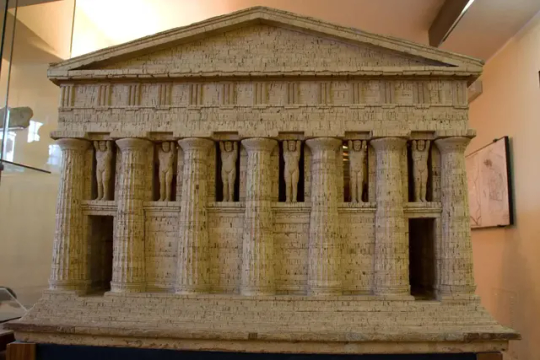
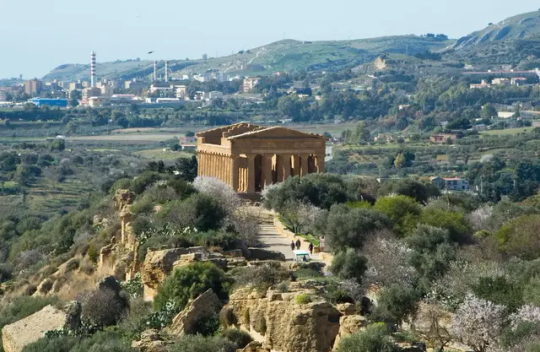
By Julia Binswanger.
#A Statue of Atlas Emerges From the Ruins of Sicily’s Ancient Temple of Zeus#Akragas#Agrigento#Sicily#Valley of the Temples park#temple#Temple of Zeus#ancient artifacts#archeology#archeolgst#history#history news#ancient history#ancient culture#ancient civilizations#roman history#roman empire#greek mythology
74 notes
·
View notes
Text

Valle dei Templi (Valley of the Temples) in Agrigento, Sicilia, ITALIA
167 notes
·
View notes
Photo

Jacques Garcia: A Sicilian Dream: Villa Elena
Agrigento, Sicilia, Italia | Houseandgarden.co.uk
#Villa Elena#Agrigento#Sicily#Sicilia#Italia#Italy#interiors#Architecture#architecture edit#my edit#so enchanting
192 notes
·
View notes
Text

Tempio di Ercole - Agrigento
14 notes
·
View notes
Text






Valley of Temples, Italy.
#temple#greek mythology#greek gods#travel#sicily#italia#agrigento#valley of temples#la valle dei templi#history#dark academia#inspo#aesthetic
20 notes
·
View notes
Text

Agrigento. Tempio di Castore e Polluce
24 notes
·
View notes
Text



🍋 #4 on our list of top finds of 2024: amazing lemon yellow Native Sulfur crystals, from the legendary Agrigento province, Sicily, Italy! These sunny sweeties were beautifully crystallized, and the bipyramidal habit was unexpected and super unique. Getting the opportunity to dig this Sicilian classic mineral was a major highlight of our rockhounding adventures in 2024! 🍋 #sulfur #nativesulfur #italiansulfur #sicily #agrigento #rockhounding #yellowcrystals #findyourowncrystals #top10findsof2024 #phenomenalgems
#phenomenalgems#crystals#Sicily#agrigento#italy#rock hounding#native sulfur#sulfur#yellow crystals#Europe trip#rocks#cool rocks#minerals
11 notes
·
View notes
Text

Temple of Juno (Hera), dating to around 450 BCE.
Valley of the Temples
Agrigento, Sicily
Dec. 2019
Explore:
#valley of the temples#agrigento#ancient greece#ancient greek#magna grecia#italia#italy#travel#original photography#photographers on tumblr#photography#lensblr#architecture#historical architecture#ancient architecture#temple#ancient temple#archaeology#sicily#sicilia#architettura#architecture photography#wanderingjana
15 notes
·
View notes
Text














Nella luce calda di un pomeriggio immobile, la storia si racconta a un cielo azzurro e grato. E ringrazio anch'io chi ama e persegue la bellezza.
Valle dei Templi - Agrigento
#lovequoteruns#panorami#colori#nature#tramonti#valle dei templi#agrigento#sicilia#vacanza#fujifilm xt30ii#3151#3152#3153#3154#3155#3156#3157#3158#3159#3160#3161#3162#3163
15 notes
·
View notes